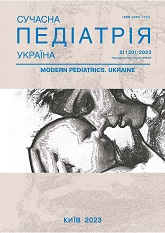Heterotopia of the gastric mucosa in the rectum: a clinical case report
DOI:
https://doi.org/10.15574/SP.2023.130.117Keywords:
pediatrics, heterotopia, stomach, rectumAbstract
Heterotopic gastric mucosa is rare in the paediatric population, but it can pose a diagnostic challenge. This pathology can occur in any part of the digestive tract, from the oropharynx to the anorectal area. Most cases are observed in the esophagus, duodenum and hepatobiliary system, but the presence of this tissue in the rectum is extremely rare.
Purpose - conduct a clinical description of a rare pathology in children in order to pay the doctors` attention to the need for comprehensive diagnosis of patients with hematochezia.
Clinical case. We present a clinical case of a child with heterotopia of the gastric mucosa into the rectum. Symptoms included hematochezia and anal pain during the act of defecation, general weakness, and decreased appetite. These manifestations were observed for two years with periods of exacerbations and remissions on the background of conservative treatment. The final diagnosis was made on the basis of a biopsy of nodular formations of the rectum, detected by colonoscopy.
Conclusions. Given the negative impact of the disease manifestations on the patient's quality of life and the potential risk of malignant transformation, the possibility of heterotopic gastric mucosa in the rectum with indeterminate bleeding from the lower gastrointestinal tract should be considered and a complete examination, including biopsy, should be performed. Once the diagnosis is confirmed, radical surgical removal is recommended. Initial conservative treatment with proton pump inhibitors provides only short-term relief and is accompanied by periods of exacerbation and remission. The final treatment is always surgical or endoscopic excision of the heterotopic mucosa.
The research was carried out in accordance with the principles of the Helsinki Declaration. The informed consent of the patient was obtained for conducting the studies.
No conflict of interests was declared by the authors.
References
Antemie G, Apostu A, Rogojan L at al. (2019). Ulcerative colitis associated with gastric heterotopia in the rectum: a case report. J Gastrointestin Liver Dis. 28 (1): 117-120. https://doi.org/10.15403/jgld.2014.1121.281.ulc
Covington D, Zong Y, Talat A at al. (2022). Mass-Forming Gastric Heterotopia of the rectum: A Series of 3 Cases from a Single Tertiary Health Center. Am J Case Rep. 23: 936631. https://doi.org/10.12659/AJCR.936631; PMid:35881563 PMCid:PMC9339256
Dinarvand P, Vareedayah A, Phillips N at al. (2017). Gastric heterotopia in rectum: A literature review and its diagnostic pitfall. SAGE Open Medical Case Reports. 5: 1-5. https://doi.org/10.1177/2050313X17693968; PMid:28321304 PMCid:PMC5347492
Fernandes S, Safavi A, Cloutier B at al. (2020). Heterotopic gastric mucosa in the rectum. Journal of Pediatric Surgery Case Reports. 63: 1-2. https://doi.org/10.1016/j.epsc.2020.101673
Galassi L, Guerrazzi G, Romeo B. (2021). Gastric Mucosa Heterotopia in Distal Rectum: a Case Report and Narrative Literature Review. Comprehensive Clinical Medicine. 3: 1469-1476. https://doi.org/10.1007/s42399-021-00897-1
Hintz G, Zou V, Baird R. (2019). Sclerotherapy for rectal prolapse in children: a systematic review and meta-analysis. J Pediatr Surg. 54 (5): 1083-1088. https://doi.org/10.1016/j.jpedsurg.2019.01.033; PMid:30782440
Iacopini F, Gotoda T. (2016). Heterotopic gastric mucosa in the anus and rectum: first case report of endoscopic submucosal dissection and systematic review. Gastroenterol Rep. 4 (3): 196-205. https://doi.org/10.1093/gastro/gow006; PMid:27103738 PMCid:PMC4976682
Kim H, Kim J. (2012). Heterotopic gastric mucosa with focal intestinal metaplasia and squamous epithelium in rectum. Dig Endosc. 24: 46-48. https://doi.org/10.1111/j.1443-1661.2011.01160.x; PMid:22211412
Mannan A, Vieth M, Khararjian A. (2018). The outlet patch: Gastric heterotopia of the colorectum and anus. Histopathology. 73 (2): 220-229. https://doi.org/10.1111/his.13632; PMid:29667709
Downloads
Published
Issue
Section
License
Copyright (c) 2023 Modern pediatrics. Ukraine

This work is licensed under a Creative Commons Attribution-NonCommercial 4.0 International License.
The policy of the Journal “MODERN PEDIATRICS. UKRAINE” is compatible with the vast majority of funders' of open access and self-archiving policies. The journal provides immediate open access route being convinced that everyone – not only scientists - can benefit from research results, and publishes articles exclusively under open access distribution, with a Creative Commons Attribution-Noncommercial 4.0 international license (СС BY-NC).
Authors transfer the copyright to the Journal “MODERN PEDIATRICS. UKRAINE” when the manuscript is accepted for publication. Authors declare that this manuscript has not been published nor is under simultaneous consideration for publication elsewhere. After publication, the articles become freely available on-line to the public.
Readers have the right to use, distribute, and reproduce articles in any medium, provided the articles and the journal are properly cited.
The use of published materials for commercial purposes is strongly prohibited.

